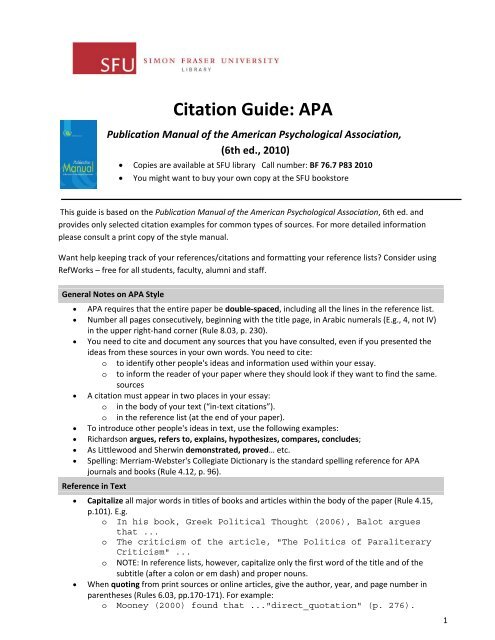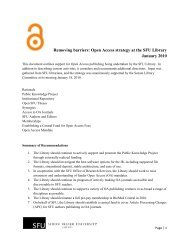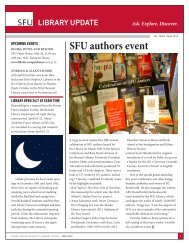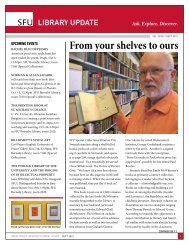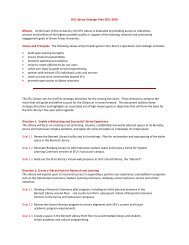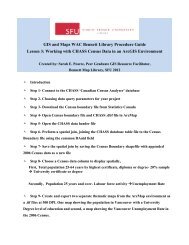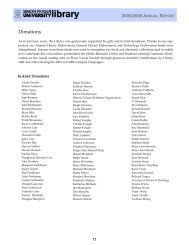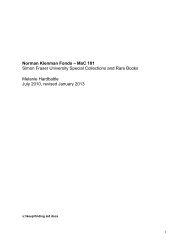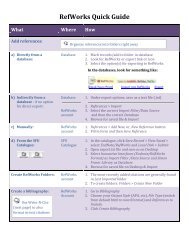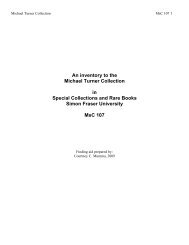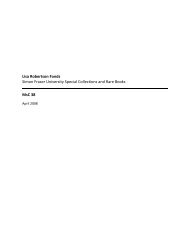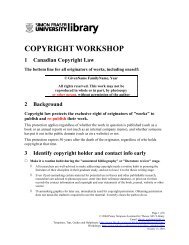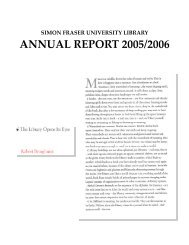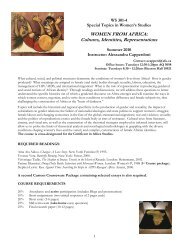Citation Guide: APA - SFU Library - Simon Fraser University
Citation Guide: APA - SFU Library - Simon Fraser University
Citation Guide: APA - SFU Library - Simon Fraser University
You also want an ePaper? Increase the reach of your titles
YUMPU automatically turns print PDFs into web optimized ePapers that Google loves.
<strong>Citation</strong> <strong>Guide</strong>: <strong>APA</strong>Publication Manual of the American Psychological Association,(6th ed., 2010) Copies are available at <strong>SFU</strong> library Call number: BF 76.7 P83 2010 You might want to buy your own copy at the <strong>SFU</strong> bookstoreThis guide is based on the Publication Manual of the American Psychological Association, 6th ed. andprovides only selected citation examples for common types of sources. For more detailed informationplease consult a print copy of the style manual.Want help keeping track of your references/citations and formatting your reference lists? Consider usingRefWorks – free for all students, faculty, alumni and staff.General Notes on <strong>APA</strong> Style<strong>APA</strong> requires that the entire paper be double‐spaced, including all the lines in the reference list.Number all pages consecutively, beginning with the title page, in Arabic numerals (E.g., 4, not IV)in the upper right‐hand corner (Rule 8.03, p. 230).You need to cite and document any sources that you have consulted, even if you presented theideas from these sources in your own words. You need to cite:o to identify other people's ideas and information used within your essay.o to inform the reader of your paper where they should look if they want to find the same.sourcesA citation must appear in two places in your essay:o in the body of your text (“in‐text citations”).o in the reference list (at the end of your paper).To introduce other people's ideas in text, use the following examples:Richardson argues, refers to, explains, hypothesizes, compares, concludes;As Littlewood and Sherwin demonstrated, proved… etc.Spelling: Merriam‐Webster's Collegiate Dictionary is the standard spelling reference for <strong>APA</strong>journals and books (Rule 4.12, p. 96).Reference in Text Capitalize all major words in titles of books and articles within the body of the paper (Rule 4.15,p.101). E.g.o In his book, Greek Political Thought (2006), Balot arguesthat ...o The criticism of the article, "The Politics of ParaliteraryCriticism" ...o NOTE: In reference lists, however, capitalize only the first word of the title and of thesubtitle (after a colon or em dash) and proper nouns. When quoting from print sources or online articles, give the author, year, and page number inparentheses (Rules 6.03, pp.170‐171). For example:o Mooney (2000) found that ..."direct_quotation" (p. 276).1
o "Direct_quotation"... (Walker, 2000, p. 135).If the quotation is over 40 words, you must start the quotation on a new line, indent the quotationabout ½ an inch, and omit the quotation marks (Rule 6.03, p. 171).Prince Edward Island is a curved slice of land from three tothirty-five miles wide and about one hundred and twenty mileslong, lying along the southern rim of the Gulf of St.Lawrence and separated from the mainland of New Brunswick andNova Scotia by the narrow waters of Northumberland Strait(Ives, 1999, p. 1).When paraphrasing from a source, or when referring to an idea contained in another work, youare encouraged to provide a page number (Rule 6.04 p. 171).Many electronic sources do not provide page numbers. In this case, use paragraph numberspreceded by the abbreviation 'para.' (Rule 6.05 pp. 171‐172). For example:(Johnson, 2003, para. 5).If a source contains neither page nor paragraph numbers, cite the heading (shorten the heading ifit is long) (Rule 6.05 pp. 171‐172).If there is no date of publication, use the abbreviation (n.d.).List two or more works by different authors who are cited within the same parentheses inalphabetical order by the first author's surname, e.g. (Anderson, 1980; Fowers & Powell, 1993;<strong>Simon</strong>etti, 1998) (Rule 6.16 p. 177).Reference ListIn <strong>APA</strong>, list of sources at the end of the paper (bibliography) is called the reference list. Thereference list must include all references cited in the text of your paper.Order of references in the reference list is alphabetical, by the last name of the first author (Rule6.25, p. 181) or, if author is not available ‐ by title.Alphabetize letter by letter. "Nothing precedes something". 'Brown, J. R.' comes before 'Browning,A. F.'.For the author's first name use only initials: 'Smith, J.', not 'Smith, Jennifer'.Second and subsequent lines of each entry are indented 5‐7 spaces.Double‐space between all lines of your work, including references.When citing books (not periodicals), capitalize only the first word of the title and of the subtitle(i.e. the first word after a colon or a dash) and proper nouns (Rule 6.29, p. 185).If more than one city of publication is listed in the book you are citing, use the first one listed.If there is no date of publication, use the abbreviation “(n.d.)”.See rules 6.22 to 6.32 of the <strong>APA</strong> Publication Manual for more information on the preparation ofthe reference list.How to cite...Book ‐ No Author or Editor (6.15, pp. 176‐177)Reference in Text (Geological field trips in southern British Columbia, 2003)According to the definition [....] (Geological field trips in southern British Columbia,2003, p.5) (when quoting).Reference ListGeological field trips in southern British Columbia. (2003). Vancouver, BC:Geological Association of Canada, Cordilleran Section.2
Comments When a work has no author, cite in text the first few words of the referencelist entry (usually the title) and the year. Within the body of the paper italicize the title of a book, brochure, or reportand capitalize all major words in titles.o In his book Greek Political Thought, Balot (2006) argued that [...]. In text, you may use a few words of the title if the title is too long.Book – Print or Electronic, One Author (6.11, pp. 174‐175)Reference in Text (Walker, 2000)(Walker, 2000, p. 62) (when quoting)Reference ListWalker, L.E. (2000). The battered woman syndrome (2nd ed.). New York:Springer.Blossom, J. (2009). Content nation: Surviving and thriving as social mediatechnology changes our lives and our future. Retrieved fromhttp://www.wiley.comMonro, V. (1835). A summer ramble in Syria: With a Tartar trip from Aleppo toStamboul (Vol. 1). Retrieved from http://books.google.com/booksSchiraldi, G.R. (2001). The post‐traumatic stress disorder sourcebook: A guide tohealing, recovery, and growth [Adobe Digital Editions version].doi:10.1036/0071393722Comments If you retrieved an e‐book from a database (e.g. Books24x7, Google Books),add the DOI (Digital Object Identifier), if available, at the end using theformat: “doi:xxxxxxx” (6.32, p. 191).If there is no DOI assigned, give the URL of the publisher's home page inplace of the DOI. You may need to do a quick web search to locate the homepage if you found the book in a library database (e.g. ebrary, Books24x7).o There is no period at the end of the URL.3
Book – Groups as Authors (6.13, p. 176)Reference in Text (National Council of Welfare, 2001)(National Council of Welfare, 2001, p. 17) (when quoting)Reference ListNational Council of Welfare (Canada). (2001). Child poverty profile, 1998. Ottawa,ON: National Council of Welfare.Comments A “Group as Author” may be a corporation, an association, a governmentagency, etc. In the example above, author and publisher are identical: 'National Councilof Welfare'. In such cases you may use the word 'Author' as the name of thepublisher. Provide the publisher if it is different from the author.Book ‐ Multiple Authors (6.12, pp. 175‐176)Reference in text (Bucher & Manning, 2006)(Bucher & Manning, 2006, p. 138) (when quoting)Reference ListBucher, K., & Manning, M.L. (2006). Young adult literature: Exploration,evaluation, and appreciation. Upper Saddle River, NJ: Pearson Education.Comments When a work has two authors, cite both names every time the referenceoccurs in text. When a work has three, four or five authors, name all authors the first timethe reference occurs; in the first subsequent citation use only the firstauthor, followed by “et al.” and a year. If you mention the same work againwithin one paragraph, omit the year. E.g.:o the first time: Smith, Jones, Pearson and Sherwin (1990) found...o the second time, as a first citation per paragraph: Smith et al. (1990)found...o mentioned again within the same paragraph: Smith et al. found... For six or more authors, cite only the last name of the first author followedby 'et al.’ When a work has two or more authors, use the word and in running text andan ampersand & in parenthetical material, in tables, captions, and in thereference list. E.g.:o as Bucher and Manning (2006) demonstrated ...o as has been shown (Bucher & Manning, 2006) ... In the reference list invert all authors' names; give last names and initials foronly up to and including seven authors. When authors number eight ormore, include the first six authors’ names, then three ellipses (…), and addthe last author’s name (6.27, p. 184).4
Edited Book (6.11, 174; 6.27, p.184)Reference in Text (Robinson, 1992)Reference ListRobinson, D. N. (Ed.). (1992). Social discourse and moral judgement. San Diego,CA: Academic Press.Comments One editor ‐ use the abbreviation (Ed.). More than one editor ‐ use theabbreviation (Eds.).Chapter – Different Authors in an Edited Book (6.27 p. 184)Reference in Text (Sharp & Eriksen, 2004)(Sharp & Eriksen, 2004, p. 126) (when quoting)Reference ListSharp, S.F., & Eriksen, M.E. (2003). Imprisoned mothers and their children. In B.H.Zaitzow & J. Thomas (Eds.), Women in prison: Gender and social control(pp. 119‐136). London: Lynne Rienner Publishers.Comments One editor ‐ use the abbreviation (Ed.). More than one editor ‐ use theabbreviation (Eds.) . In the example above, 'Sharp & Eriksen' are the authors of the chapter'Imprisoned mothers and their children', published in the book 'Women inprison: Gender and social control'. For a book with no editor, include the word 'In' before the book title.Journal Article ‐ Print Version (6.27‐6.30, pp. 184‐187)Reference in Text (Louth, Hare & Linden, 1998)Louth et al. (1998, p. 198) found that ["........."]. (when quoting)Louth et al. (1998) found that [".........."] (p. 198). (when quoting)Reference ListLouth, S.M., Hare, R.D., & Linden, W. (1998). Psychopathy andalexithymia in female offenders. Canadian Journal of BehaviouralScience, 30(2), 91‐98.Comments If, and only if, each issue of a journal begins on page 1, give the issuenumber in parentheses (not italicized) immediately after the volume number(which is italicized). There is no space between the volume and issuenumber. When a work has two authors, cite both names every time the referenceoccurs in text (6.11, p. 174). When a work has three, four or five authors, name all authors the first timethe reference occurs; in the first subsequent citation use only the first5
author, followed by 'et al.' and a year. If you mention the same work againwithin one paragraph, omit the year. E.g.:o the first time: Louth, Hare and Linden (1998) found...o the second time, as a first citation per paragraph: Louth et al. (1998)found...o mentioned again within the same paragraph: Louth et al. found...For six or more authors, cite only the last name of the first author followedby 'et al.' and a year (6.12, p. 175).When a work has two or more authors, use the word and in running text andan ampersand & in parenthetical material, in tables, captions, and in thereference list. E.g.:o as Bucher and Manning (2006) demonstrated ...o as has been shown (Bucher & Manning, 2006) ...In the reference list invert all authors' names; give last names and initials foronly up to and including seven authors. When authors number eight ormore, include the first six authors’ names, then three ellipses (…), and addthe last author’s name (6.27, p. 184).Journal Article – Electronic (6.32, pp. 189‐192)Retrieved from a database, such as PsycINFO, Academic Search Premier, JSTOR, etc. or on the internetReference in Text (Turner, 2007)(Turner, 2007, p. 292) (when quoting)(Lynch, 2004, para. 3) (when quoting an article without page numbers)(Gruenwald, 2009, "Phytic Acid Contributes to") (quoting an article without page orparagraph numbers, using a shortened heading)Reference List Turner, J. (2007). Justice and emotions. Social Justice Research, 20(3), 288‐311. doi:10.1007/s11211‐007‐0043‐yWalters, W. (2008). Bordering the sea: Shipping industries and the policing ofstowaways. Borderlands E‐ Journal, 7(3), 1‐25. Retrieved fromhttp://www.borderlands.net.au/index.htmlLedger, W., Wiebinga, C., Anderson, P., Irwin, D., Holman, A., & Lloyd, A. (2009).Costs and outcomes associated with IVF using recombinant FSH. ReproductiveBioMedicine Online, 19(3), 337‐342. Retrieved fromhttp://www.rbmonline.com/Comments For electronic versions based on a print source (such as PDF), include pagenumbers (6.32, p. 189). The retrieval date is not required unless the source material is likely tochange over time. Generally it is not necessary to include information about which database it6
was retrieved from (6.32, p. 192).When a DOI (Digital Object Identifier) is available, include the DOI right afterthe volume/issue number using the format: “doi:xxxxxxx” (6.32, p. 191)If there is no DOI assigned, give the URL of the journal publisher’s homepage in place of the DOI. You may need to do a quick web search to locatethe publisher if you found the article in a library database (e.g. AcademicSearch Premier, ScienceDirect).There is no period at the end of the URL.Article in Daily Newspaper, Print or Electronic (6.27‐6.32, pp. 184‐192)Reference in Text ("All four pillars", 2004)(Freeze, 2009)Reference ListAll four pillars needed to combat drug scourge. (2004, May 15). TheVancouver Sun, p. C6.Freeze, C. (2009, October 7). ‘Toronto 18’ leader pleads guilty. The Globeand Mail. Retrieved from http://www.theglobeandmail.comComments In text, if the article does not have an author, use a title (shorten, ifnecessary). Put the title in quotes. If an article appears on discontinuous pages (e.g. starts on p.D1 andcontinues on p.D5), give all page numbers, separated by a comma. To cite a "letter to the editor", include the text [Letter to the editor] insquare brackets, right after the title of the letter and before the title of thenewspaper. There is no period after the title of the letter. If you retrieved the article from a database (e.g. Canadian Newsstand,CBCA), add the DOI (Digital Object Identifier) at the end using the format:“doi:xxxxxxx” (6.32, p. 191). If there is no DOI assigned, give the URL of the newspaper’s home page inplace of the DOI. You may need to do a quick web search to locate the homepage if you found the article in a library database (e.g. Canadian Newsstand,PressDisplay).o There is no period at the end of the URL.Article in Magazine, Print or Electronic (6.27‐6.30, pp. 184‐186)Reference in Text (Morell, 2006)(Morell, 2006, p. 131) (when quoting)Reference List Morell, V. (2006, March). Wolves of Ethiopia. National Geographic, 209, 124‐135.Mauro, S. (2009, November). A red tail returns. Aviation History 20(2). Retrieved7
from http://www.aviationhistory.org/am_aviation_history_magazine.htmlComments Give the date shown on the publication: month for monthlies / month andday for weeklies. If you retrieved the article from a database (e.g. Canadian ReferenceCentre, MasterFile Premier), add the DOI (Digital Object Identifier) at theend using the format: “doi:xxxxxxx” (6.32, p. 191). If there is no DOI assigned, give the URL of the magazine’s home page inplace of the DOI. You may need to do a quick web search to locate the homepage if you found the article in a library database (e.g. MasterFile Premier,CBCA).o There is no period at the end of the URL.Website ‐ A Document Created by an Individual or an Organization (6.31‐6.32 & 7.11, pp. 187‐192, 214‐215)Reference in Text (International Federation of <strong>Library</strong> Associations, 2003)(International Federation of <strong>Library</strong> Associations, 2003, para. 4) (when quoting)Reference list International Federation of <strong>Library</strong> Association and Institutions. (2003,February 03). <strong>Library</strong> & information science: <strong>Citation</strong> guides forelectronic documents. Retrieved fromhttp://ifla.org/I/training/citation/citing.htmComments When citing a web site in the Reference List, provide as much as possible ofthe following information: Author's name (if available). Date of publication or update in parentheses (if available). Ifthere is no date, use '(n.d.)' instead. Title or description of document. Title of complete work (if relevant), in italics or underlined. URL. When making in‐text citations, use paragraph numbers (abbreviated to“para.”) if page numbers are not available. If there are no paragraphnumbers, use the heading. The heading may be shortened if necessary. Do not include retrieval dates unless the source material is likely to changeover time (e.g. blogs, wikis) There is no period after the URL. Do not insert a hyphen when breaking a long URL.8
Website ‐ A Single Document or Part of a Large Website (6.32, 7.11,pp. 189‐192, 214‐215)Reference in Text (Spearing, 2004)(Spearing, 2004, “Eating Disorders are Treatable,”) (when quoting)Reference ListSpearing, M. (2004 May). Eating disorders: Facts about eating disordersand the search for solutions. Retrieved fromhttp://www.nimh.nih.gov/publicat/eatingdisorders.cfmJess. (2009, April 18). Some things I have learned about teens [Web logpost]. Retrieved from http://coollibrarianblog.blogspot.com/2009/04/some‐things‐i‐have‐learned‐about‐teens.htmlComments For blogs, include the name of the blog to which the entry was posted, if thisinformation is not part of the URL. If the author’s full name is unavailable,use the screen name. When making in‐text citations, use paragraph numbers (abbreviated to“para.”) if page numbers are not available. If there are no paragraphnumbers, use the heading. The heading may be shortened if necessary. Do not insert a hyphen when breaking a long URL.Website ‐ Chapter or Section in a document (6.32, 6.19, 6.05, pp. 192, 179, 171‐172)Reference in Text (Benton Foundation, 1998)(Benton Foundation, 1998, Chapter 2) (when quoting)Reference ListBenton Foundation. (1998, July 7). Barriers to closing the gap. In Losingground bit by bit: Low‐income communities in the information age(chap.2). Retrieved from http://www.benton.org/publibrary/losing‐ground/two.htmlComments 'Barriers to closing the gap' is the title of Chapter 2 of the Web document'Losing ground bit by bit'. When making in‐text citations, use paragraph numbers (abbreviated to“para.”) if page numbers are not available. If there are no paragraphnumbers, use the heading. The heading may be shortened if necessary. Provide a URL that links directly to the chapter or section. Do not insert a hyphen when breaking a long URL.9
Website ‐ No author, no date (6.27, 6.28, 6.15, pp. 184, 185, 176‐177)Reference in TextReference List("GVU's 10 th WWW User Survey," n.d.)GVU’s 10th WWW user survey. (n.d.). Retrieved fromhttp://www.gvu.gatech.edu/user_surveys/survey‐1998‐10/When making in‐text citations, use paragraph numbers (abbreviated to“para.”) if page numbers are not available. If there are no paragraphnumbers, use the heading. The heading may be shortened if necessary.Encyclopedia or Dictionary, Print or Electronic (7.02, pp. 202‐203)Reference in Text (Sadie, 1980)(Sadie, 1980, p.100) (when quoting)Reference ListSadie, S. (Ed.). (2000). The new Grove dictionary of music and musicians(2nd ed., Vols. 1‐29). New York: Grove's Dictionaries.Zalta, E. N. (Ed.). (2007). The Stanford encyclopedia of philosophy.Retrieved from http://plato.stanford.edu/Comments If you retrieved the entry from a database (e.g. Gale Virtual Reference<strong>Library</strong>), add the DOI (Digital Object Identifier) at the end using the format:“doi:xxxxxxx” (6.32, p. 191).If there is no DOI assigned, give the URL of the publisher's home page inplace of the DOI. You may need to do a quick web search to locate the homepage if you found the item in a library database (e.g. Oxford ReferenceOnline, Gale Virtual Reference <strong>Library</strong>).o There is no period at the end of the URL.Entry in an Encyclopedia or Dictionary, Print or Electronic (7.02, pp. 202‐203)Reference in Text (Firdion, 2004)(Firdion, 2004, p.169) (when quoting)Reference ListEtzkowitz, H. & Dzisah, J. (2009). <strong>University</strong>–industry relationships. In J.B.Callicott & R. Froderman (Eds.), Encyclopedia of environmentalethics and philosophy (Vol. 2, pp. 344‐346). Retrieved fromhttp://www.gale.cengage.com/.Firdion, J.M. (2004). Foster care. In Encyclopedia of homelessness (Vol. 1,10
pp. 167‐170). Thousand Oaks, CA:Sage Publications.Jaunty. (1989). Oxford English dictionary (2nd ed.). Retrieved fromhttp://oed.com/Comments If there is no author or editor of the entry, as in the last example, place thetitle in the author position. If an online version refers to a print version, include the edition numberafter the title.Informally Published or Self‐Archived Work, Such as From ERIC Database (7.09, pp. 211‐212)Reference in Text (Skala, 2003)(Skala, 2003, p. 49) (when quoting)Reference ListSkala, C. (2003). Optimizing basic French skills utilizing multiple teachingtechniques. Retrieved from ERIC database. (ED498566)Audiovisual Media ‐ Videos, Music Recordings, Maps Retrieved Online, Podcasts, etc. (7.07, p. 209‐210)Reference in Text (Gladu & Brodeur, 2001)Reference ListGladu, A. (Producer), & Brodeur. M. (Director). (1999). Dance of thewarrior [Motion picture]. Canada: National Film Board.Manhattan77. (2007, February 25). Ghost Towns and Death Valley [Videofile]. Retrieved from http://www.youtube.com/watch?v=RGCnyH6n2sw&feature=video_responseComments There is no period after the title. If the author's full name is unavailable, use a screen name. Do not insert a hyphen when breaking a long URL.Secondary Source (6.17, p. 178)Reference in TextReference ListSeidenberg and McClelland's study showed (as cited in Coltheart, Curtis, Atkins, &Haller, 1993) that [...]Coltheart, M., Curtis, B., Atkins, P., & Haller, M. (1993). Models of readingaloud: Dual‐route and parallel‐distributed‐processing approaches.Psychological Review, 100, 589‐608.Comments What you have in hand (Coltheart) is 'the secondary source', and the original11
work that has been cited in your source (Seidenberg) is 'the primary source'.In the reference list give the secondary source (the one you have in hand;the one you consulted).In text, name the primary source (Seidenberg), and give the citation to thesecondary source: ('as cited in...')Conference Proceedings – Print or Electronic (7.04, pp. 206‐207)Reference in Text (Iyengar & DeVoe, 2003)Reference ListIyengar, S. S., & DeVoe, S. E. (2003). Rethinking the value of choice: Consideringcultural mediators of intrinsic motivation. In R. Dienstbier (Ed.), NebraskaSymposium on Motivation: Vol. 49. Cross‐cultural differences inperspectives on the self (pp. 129‐174). Lincoln: <strong>University</strong> of NebraskaPress.Shennan, S. (2008). Canoes and cultural evolution. Proceedings of theNational Academy of Sciences 105, 3416‐3420. doi:10.1073/pnas.0800666105Comments Published conference proceedings may be cited either like chapters inedited books (first example) or like journal articles (second example). Thiswill depend on whether the publication is treated as a series (e.g. has anISBN and an editor) or as a periodical (i.e. it is published annually). For unpublished conference papers and contributions see Rule 7.04, p.206. Capitalize the name of the symposium, conference or meeting.Personal Communications, Interviews and Class notes (6.20, p. 179)Reference in TextReference ListIn his interview M.S. Bloomberg (personal communication, April 22, 2007) talksabout...Not Usually ApplicableComments Personal communications may be letters, e‐mails, interviews, telephoneconversations, etc. Some forms of personal communication are recoverable, and these shouldbe referenced as archival material (See Rule 7.10, pp.212‐214 for examplesof archival material). Unpublished, unrecoverable personal communications are not included inthe reference list because they do not provide recoverable data. Cite in textonly. Cite information from your own class notes as a personal communication12
and refer to it only in the body of your paper (e.g. In a lecture on September23, 2007 to a PSYC 103 class, Professor Brown said... ).Published interviews are included in the reference list. If the publishedinterview has a title, include it after the year. Give further description in[brackets] if necessary. Provide the original source where the interview waspublished (e.g. a print journal article with one author, a website, etc.) andchoose the format accordingly.If the published interview lacks a title, give a description of the interview in[brackets].See Rule 7.11, pp. 214‐215 for citing messages posted to newsgroups, onlineforums and electronic mailing lists.Tables and Figures ‐‐ Charts, Graphs, Maps, Photographs, etc. (Chapter 5, pp. 125‐167)Reference BelowTable or FigureNote. Adapted from "The Role of the Shared Family Context in DifferentialParenting," by J.M. Jenkins, J. Rasbash, and T.G. O'Connor, 2003, DevelopmentalPsychology, 39, p.104. Copyright 2003 by the American Psychological Association.Comments Include the word Note: before your citation. The citation follows a different format from the other examples listed here,and is placed below the table or figure. Use this citation form for tables or figures from another source which youreprint.Custom CoursewareCommentsCustom Courseware packages are compilations of journal articles, bookchapters and other materials selected by your instructor. The <strong>APA</strong> manualdoes not give specific advice about citing these materials, so you will haveto use your judgment and come up with your own solution.If you need to cite a source from a Custom Courseware package, here aretwo suggestions. However, our strong recommendation is to first checkwith your instructor.1. Find the full citation where the article, chapter, etc. was originallypublished, and cite accordingly. The full citations may be included on thefirst page of the coursepack. If not, search a relevant database or thelibrary catalogue, or ask a librarian.2. Treat the Courseware package as an anthology, and the instructor whodid the compilation as a book editor/compiler. Therefore, treat the article,chapter, etc. as if it was part of an anthology, or edited book. Mostprobably you will not have the page numbers, since the CustomCourseware is not a true publication and is not paginated throughout. Youwill also have to include the name of the compiler, the title of theCourseware, the name of the course (e.g. CMNS 210), the semester (e.g.13


